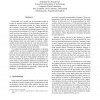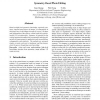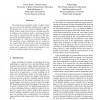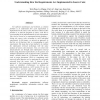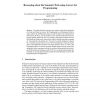102
click to vote
HLK
2003
IEEE
15 years 6 months ago
2003
IEEE
Modeling and visualization of city scenes is important for many applications including entertainment and urban mission planning. Models covering wide areas can be efficiently cons...
HLK
2003
IEEE
15 years 6 months ago
2003
IEEE
In some applications objects are known to have nonsmooth or “jagged” edges, which are not well approximated by smooth curves. We use subdivision curves as a simple but flexib...
113
click to vote
HLK
2003
IEEE
15 years 6 months ago
2003
IEEE
Deformable 3–D models can be represented either as explicit or implicit surfaces. Explicit surfaces, such as triangulations or wire-frame models, are widely accepted in the Comp...
96
Voted
HLK
2003
IEEE
15 years 6 months ago
2003
IEEE
Based on high-level geometric knowledge, especially symmetry, imposed upon objects in images, we demonstrate in this paper how to edit images in terms of correct 3-D shape and rel...
168
Voted
HLK
2003
IEEE
15 years 6 months ago
2003
IEEE
It’s common experience for human vision to perceive full 3D shape and scene from a single 2D image with the occluded parts “filled-in” by prior visual knowledge. In this pa...
111
Voted
HLK
2003
IEEE
15 years 6 months ago
2003
IEEE
Three-dimensional morphable models of object classes are a powerful tool in modeling, animation and recognition. We introduce here the new concept of regularized 3D morphable mode...
APSEC
2003
IEEE
15 years 6 months ago
2003
IEEE
For software maintenance and evolution, a common problem is to understand how each requirement is implemented in the source code. The basic solution of this problem is to find the...
147
Voted
AGP
2003
IEEE
15 years 6 months ago
2003
IEEE
The paper discusses some innovative aspects related to the integration of a framework based on Answer Set Programming in an Information Retrieval Agent, namely, the Global Search A...
101
click to vote
TAL
2004
Springer
15 years 6 months ago
2004
Springer
Word fragments or n-grams have been widely used to perform different Natural Language Processing tasks such as information retrieval [1] [2], document categorization [3], automatic...
105
Voted
SPATIALCOGNITION
2004
Springer
15 years 6 months ago
2004
Springer
Establishing a clean relationship between a robot’s spatial model and natural language components is a non-trivial task, but is key to designing verbally controlled, navigating s...

